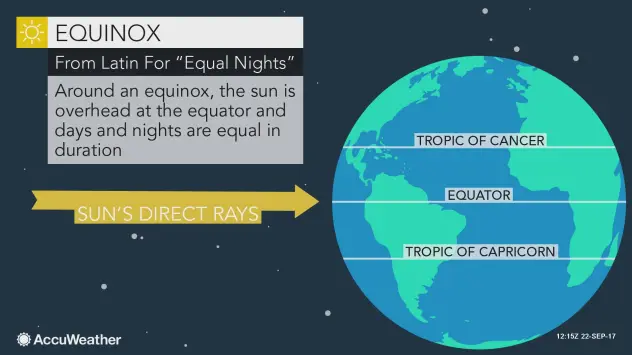By AccuWeather meteorologist and staff writer
The autumnal equinox marks the start of fall across the Northern Hemisphere, but meteorologists commonly consider a different date to mark the start of the new season.
Equinox comes from the Latin words aequi, which means equal, and nox, which means night. On the day of the equinox, the sun’s rays are most direct over the equator. No matter the location around the globe, the sun will rise exactly due east and set exactly due west.

Astronomical fall starts on the autumnal equinox, between Sept. 21 and Sept. 23, and ends on the winter solstice, between Dec. 20 and Dec. 22.
These dates vary from year to year due to leap years and the elliptical shape of Earth's orbit around the Sun, with the autumnal equinox in 2018 falling on Saturday, Sept. 22.
While this equinox signals the start of astronomical fall across the Northern Hemisphere, those in the Southern Hemisphere recognize it as the first day of spring.
CLICK HERE FOR THE FREE ACCUWEATHER APP
Traditional, astronomical seasons last between 89 and 93 days due to the elliptical shape of the Earth’s orbit around the sun, according to the National Centers for Environmental Information (NCEI).
This variability can make it difficult for experts to compare statistics from one year to another.
Meanwhile, meteorological seasons are more consistent with the four seasons being broken into groups of three months.
Every year, meteorological fall lasts for 91 days, starting on Sept. 1 and lasting through Nov. 30.
-
Meteorological spring is March, April and May.
-
Meteorological summer is June, July and August.
-
Meteorological fall is September, October and November.
-
Meteorological winter is December, January and February.
“By following the civil calendar and having less variation in season length and season start, it becomes much easier to calculate seasonal statistics from the monthly statistics, both of which are very useful for agriculture, commerce and a variety of other purposes,” NCEI said.

One common misconception is that the equinox is the only time of the year that it is possible to balance an egg on its end.
"The origins of this myth are attributed to stories that the ancient Chinese would create displays of eggs standing on end during the first day of spring," John Millis, assistant professor of physics and astronomy at Anderson University said.
Although it is possible to stand an egg on end on the equinox, the trick is also able to be accomplished every other day of the year.
“You can get lucky and balance an egg anytime. It doesn’t have anything to do with the equinox,” AccuWeather Astronomy Blogger Dave Samuhel said.
RELATED:
While autumn is known for its shorter days and cooler conditions, it also brings a heightened risk of severe weather.
“The second severe peak happens in the fall because you see the jet stream start to shift southward in response to the Northern Hemisphere cooling off,” AccuWeather Southeast Weather Expert Frank Strait said.
This shift in the jet stream can bring powerful storm systems to the central and eastern United States, capable of spawning damaging winds, hail and even tornadoes.
The frequency of severe thunderstorms gradually decreases near the end of the season as the Northern Hemisphere begins to transition to winter.
Keep checking back on AccuWeather.com and stay tuned to the AccuWeather Network on DirecTV, Frontier, Spectrum, FuboTV, Philo, and Verizon Fios.

No comments:
Post a Comment